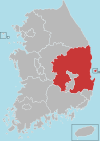Chilgok County
This article relies largely or entirely on a single source. (May 2018) |
Chilgok
칠곡군 | |
|---|---|
| Korean transcription(s) | |
| • Hangul | 칠곡군 |
| • Hanja | 漆谷郡 |
| • Revised Romanization | Chilgok-gun |
| • McCune-Reischauer | Ch'ilgok-kun |
 Location in South Korea | |
| Country | |
| Region | Yeongnam |
| Administrative divisions | 3 eup, 5 myeon |
| Area | |
| • Total | 451 km2 (174 sq mi) |
| Population | |
| • Total | 107,158 |
| • Density | 237.6/km2 (615/sq mi) |
| • Dialect | Gyeongsang |
Chilgok County (Chilgok-gun) is located at south-west part of North Gyeongsang Province. It is close by Gunwi County on the east while adjoins with Gimchon-si, Seongju County on the west. It is also a transportation hub where the Nakdong river flows through and an Urban-Farming complex that adjoins with Gumi City and Daegu Metropolitan city.
It is home to the famous Cheonsaengsanseong Fortress, a battle field where general Gwak Jae-woo fought during the Japanese Invasion of Korea in 1592, as well as the Gasansanseong Fortress, which was built to prevent a Japanese invasion after the second Manchu invasions in 1636. It is also a battle field of the Nakdong River and Dabudong battles during the Korean war.
History
[edit]It was Palgeorihyeon or Bukchijangnihyeon, Illihyeon and King Gyeongdeok of Silla (the 35th ruler who reigned from 742 to 765 over the kingdom of Silla) revised it to Pal-ri of which become affiliated to Suchang-guen.
It was revised to Palgeo in the early part of Goryeo period and during King Hyeonjong of Goryeo (the 8th ruler who reigned from 1010-1031), it become affiliation of Gyonsanbu which is the present lord of the castle.
In 1640 when King Injo of Joseon (the 16th ruler who reigned from 1623-1649) reign for 18th year, it was called Chilgok by installing regional military command and Gasansanseong Fortress. In 1895 King Gojong's (the 26th ruler who reigned from 1863-1907) 32nd year of reign, Chilgok was re-entitled to Chilgok-guen which led to become a part of Daegu. In accordance with rearrangement of Buguen-myeon in 1914, it incorporated with 9 myeon of Indong-guen , Yakmok-myeon which used to be Daemok or ChilchonㆍGonsanhyeon during Silla dynasty and transferred the location of the county to Waegwan.
Geography and climate
[edit]Its geographical coordinate is 128°18'-128°38'to the east longitude and the north latitude 35°52' - 36°38' with average temperature of 14.8 °C and 948mm amount of rainfall.
Administrative divisions
[edit]
Chilgok County is divided into 3 eup and 5 myeon.
| Name | Hangeul | Hanja |
|---|---|---|
| Waegwan-eup | 왜관읍 | 倭館邑 |
| Buksam-eup | 북삼읍 | 北三邑 |
| Seokjeok-eup | 석적읍 | 石積邑 |
| Jicheon-myeon | 지천면 | 枝川面 |
| Dongmyeong-myeon | 동명면 | 東明面 |
| Gasan-myeon | 가산면 | 架山面 |
| Yakmok-myeon | 약목면 | 若木面 |
| Gisan-myeon | 기산면 | 岐山面 |
Tourism
[edit]Chilgok Patriots & Peace Memorial is a memorial museum dedicated to the soldiers who seized victory by holding up a fierce battle at Nakdong River's line of defense for 55 days in Chilgok during the Korean War. The museum consists of a spacious four-story high building with two basement floors and an outdoor exhibition with a variety of artifacts. The museum also has battle miniatures and experience facilities to help foster patriotism and appreciation for the soldiers who gave their lives to protect the country.[1] 3.
References
[edit]- ^ "Chilgok Patriots & Peace Memorial (칠곡호국평화기념관) - Culture - Korea travel and tourism information". www.koreatriptips.com. Retrieved 2020-09-01.



